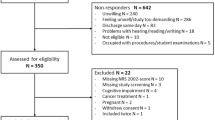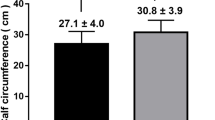Abstract
Background & aims
The Global Leadership Initiative on Malnutrition (GLIM) is new criteria for diagnosing malnutrition that need validation adjusted to race. Our aim is to determine the optimal reference values of calf circumference (CC), investigate the prevalence of GLIM-defined malnutrition based on different screening tools in inpatients over 70 years old in China and assess its relationship with clinical outcomes.
Methods
We designed two continuity studies by analyzing a prospective multicenter database. First, we estimated and validated the CC cut-off values by receiver operating characteristic analyses against in-hospital mortality. Then the patients who were at risk by NRS 2002, MNA-SF and MUST were assessed by the GLIM criteria using the new CC values. Some clinical parameters and outcome data were evaluated.
Results
The optimal cut-off values of CC were 29.6 cm for male patients and 27.5 cm for female patients. The prevalence of GLIM-defined malnutrition was 27.5% by using NRS2002, 32.6% by using MNA-SF and 25.4% by using MUST. Patients with GLIM-defined malnutrition showed significantly worse values in BMI, total protein, albumin, neutrophil/lymphocyte ratio, CC, rate of complication, in-hospital mortality, length of stay, and total hospital cost than normal patients. Multivariate logistic regression showed the odds ratio of in-hospital mortality was significantly associated with GLIM defined malnutrition by using MNA-SF [OR = 1.231, 95%CI (1.022, 1.484), P = 0.029].
Conclusions
The Chinese reference values of CC for inpatients over 70 years old were validated by in-hospital mortality, which could be implemented in GLIM criteria. And this population possessed a high prevalence of nutrition risk and malnutrition. GLIM criteria with MNA-SF seems to be the first choice to diagnose malnutrition.



Similar content being viewed by others
References
Crichton M, Craven D, Mackay H, Marx W, de van der Schueren M, Marshall S. A systematic review, meta-analysis and meta-regression of the prevalence of protein-energy malnutrition: associations with geographical region and sex. Age Ageing 2019; 48:38–48.
Cederholm T, Jensen GL, Correia MITD, Gonzalez MC, Fukushima R, Higashiguchi T, et al. GLIM criteria for the diagnosis of malnutrition — A consensus report from the global clinical nutrition community. Clin Nutr 2019; 38:1–9.
Kondrup J, Alison SP, Elia M, Vellas B, Plauth M; Educational and Clinical Practice Committee, European Society of Parenteral and Enteral Nutrition (ESPEN). ESPEN Guidelines for Nutrition Screening 2002. Clin Nutr 2003,2:415–421.
Wei J, Chen W, Zhu M, Cao W, Wang X, Shi H, et al. Guidelines for Parenteral and Enteral Nutrition Support in Geriatric Patients in China. Asia Pac J Clin Nutr 2015;24:336–346.
Xu J, Jiang Z. Different risk scores consider different types of risks: the deficiencies of the 2015 ESPEN consensus on diagnostic criteria for malnutrition. Eur J Clin Nutr 2018; 72:936–941.
Contreras-Bolívar V, Sánchez-Torralvo FJ, Ruiz-Vico M, González-Almendros I, Barrios M, Padín S, et al. GLIM Criteria Using Hand Grip Strength Adequately Predict Six-Month Mortality in Cancer Inpatients. Nutrients 2019;11:2043.
Kondrup J, Rasmusen HH, Hamberg O, Stanga Z; Ad Hoc ESPEN Working Group. Nutritional risk screening (NRS2002): a new method based on an analysis of controlled clinical trials. Clin Nutr 2003, 22: 321–336.
Rubenstein LZ, Harker JO, Salva A, Guigoz Y, Vellas B. Screening for undernutrition in geriatric practice: developing the short-form mini-nutritional assessment (MNASF). J Gerontol A Biol Sei Med Sei 2001;56:M366–372.
Stratton RJ, Hackston A, Longmore D, Dixon R, Price S, Stroud M, et al. Malnutrition in hospital outpatients and inpatients: prevalence, concurrent validity and ease of use of the ‘malnutrition universal screening tool’ (‘MUST’) for adults. Br J Nutr 2004; 92:799–808.
Dindo D, Demartines N, Clavien PA. Classification of surgical complications: a new proposal with evaluation in a cohort of 6336 patients and results of a survey. Ann Surg 2004;240:205–213.
American College of Chest Physicians/Society of Critical Care Medicine Consensus Conference. Definitions for sepsis and organ failure for the use of innovative therapies in sepsis. Crit Care Med 1992;20:864–873.
Chen LK, Liu LK, Woo J, Assantachai P, Auyeung TW, Bahyah KS, et al. Sarcopenia in Asia: consensus report of the Asian Working Group for Sarcopenia. J Am Med Dir Assoc 2014; 15:95–101.
Bonnefoy M, Jauffret M, Kostka T, Jusot JF. Usefulness of calf circumference measurement in assessing the nutritional state of hospitalized elderly people. Gerontology 2002; 48:162–169.
Maeda K, Koga T, Nasu T, Takaki M, Akagi J. Predictive accuracy of calf circumference measurements to detect decreased skeletal muscle mass and European society for clinical nutrition and metabolism-defined malnutrition in hospitalized older patients. Ann Nutr Metab Tab 2017; 71:10–15.
Kaiser MJ, Bauer JM, Rämsch C, Uter W, Guigoz Y, Cederholm T, et al. Frequency of malnutrition in older adults: a multinational perspective using the mini nutritional assessment. J Am Geriatr Soc 2010; 58:1734–1738.
Maeda K, Ishida Y, Nonogaki T, Mori N. Reference body mass index values and the prevalence of malnutrition according to the Global Leadership Initiative on Malnutrition criteria. Clin Nutr 2020; 39:180–184.
Mueller C, Compher C, Ellen DM; American Society for Parenteral and Enteral Nutrition (A.S.P.E.N.) Board of Directors. A.S.P.E.N. clinical guidelines: Nutrition screening, assessment, and intervention in adults. JPEN J Parenter Enteral Nutr 2011; 35:16–24.
van Bokhorst-de van der Schueren MA, Guaitoli PR, Jansma EP, de Vet HC. Nutrition screening tools: does one size fit all. A systematic review of screening tools for the hospital setting. Clin Nutr 2014; 33:39–58.
Matsumoto Y, Iwai K, Namikawa N, Matsuda S, Wakano C, Heya H, et al. The relationship between existing nutritional indicators and Global Leadership Initiative on Malnutrition (GLIM) criteria: A one-institution cross-sectional analysis. Clin Nutr 2020 Jan 31. pii: S0261-5614(20)30039-X.
Skeie E, Tangvik RJ, Nymo LS, Harthug S, Lassen K, Viste A. Weight loss and BMI criteria in GLIM’s definition of malnutrition is associated with postoperative complications following abdominal resections e Results from a National Quality Registry. Clin Nutr 2019 Jul 20. pii: S0261-5614(19)30285-7.
Karavetian M, Salhab N, Rizk R, Poulia KA. Malnutrition-Inflammation Score VS Phase Angle in the Era of GLIM Criteria: A Cross-Sectional Study among Hemodialysis Patients in UAE. Nutrients 2019 Nov 14; 11(11). pii: E2771.
Cederholm T, Bosaeus I, Barazoni R, Bauer J, Van Gossum A, Klek S, et al. Diagnostic criteria for malnutrition: An ESPEN Consensus Statement. Clin Nutr 2015,34:335–340.
Cederholm T, Barazzoni R, Austin P, Ballmer P, Biolo G, Bischoff SC, et al. ESPEN guidelines on definitions and terminology of clinical nutrition. Clin Nutr 2017;36:49–64.
Soeters P, Bozzetti F, Cynober L, Forbes A, Shenkin A, Sobotka L. Defining malnutrition: A plea to rethink. Clin Nutr 2017; 36:896–901.
White JV, Guenter P, Jensen G, Malone A, Schofield M; Academy of Nutrition and Dietetics Malnutrition Work Group; A.S.P.E.N. Malnutrition Task Force; A.S.P.E.N. Board of Directors. Consensus statement: Academy of Nutrition and Dietetics and American Society for Parenteral and Enteral Nutrition: characteristics recommended for the identification and documentation of adult malnutrition (undernutrition). JPEN J Parenter Enteral Nutr 2012; 36:275–283.
Probst P, Haller S, Bruckner T, Ulrich A, Strobel O, Hackert T, et al. Prospective trial to evaluate the prognostic value of different nutritional assessment scores in pancreatic surgery (NURIMAS Pancreas). Br J Surg 2017; 104:1053–1062.
Acknowledgements
The authors thank the support of members of Geriatric Study Group and [Nutritional screening — Undernutrition — Support — Outcome — Cost/effectiveness ratio (NUSOC) multicenter data sharing cooperative group] from Chinese Society for Parenteral and Enteral Nutrition (CSPEN).
Funding
Funding sources Statement: This research did not receive any specific grant from funding agencies in the public, commercial, or not-for-profit sectors.
Author information
Authors and Affiliations
Corresponding author
Ethics declarations
Conflict of Interest: The authors have no conflict of interest issue with this study.
Additional information
Statement of authorship: (I) Conception and design: JM Wei, JY Xu; (II) Administrative support: JM Wei; (III) Provision of study materials or patients: JM Wei. MW Zhu; (IV) Collection and assembly of data: JY Xu, H Zhang, L LI, PX Tang; (V) Data analysis and interpretation: JY Xu, W Chen, H Zhang, L Li; (VI) Manuscript writing: All authors; (VI) Final approval of manuscript: All authors.
Rights and permissions
About this article
Cite this article
Xu, JY., Zhu, MW., Zhang, H. et al. A Cross-Sectional Study of Glim-Defined Malnutrition Based on New Validated Calf Circumference Cut-Off Values and Different Screening Tools in Hospitalised Patients over 70 Years Old. J Nutr Health Aging 24, 832–838 (2020). https://doi.org/10.1007/s12603-020-1386-4
Received:
Accepted:
Published:
Issue Date:
DOI: https://doi.org/10.1007/s12603-020-1386-4




